125 YEARS OF MOTORSPORT
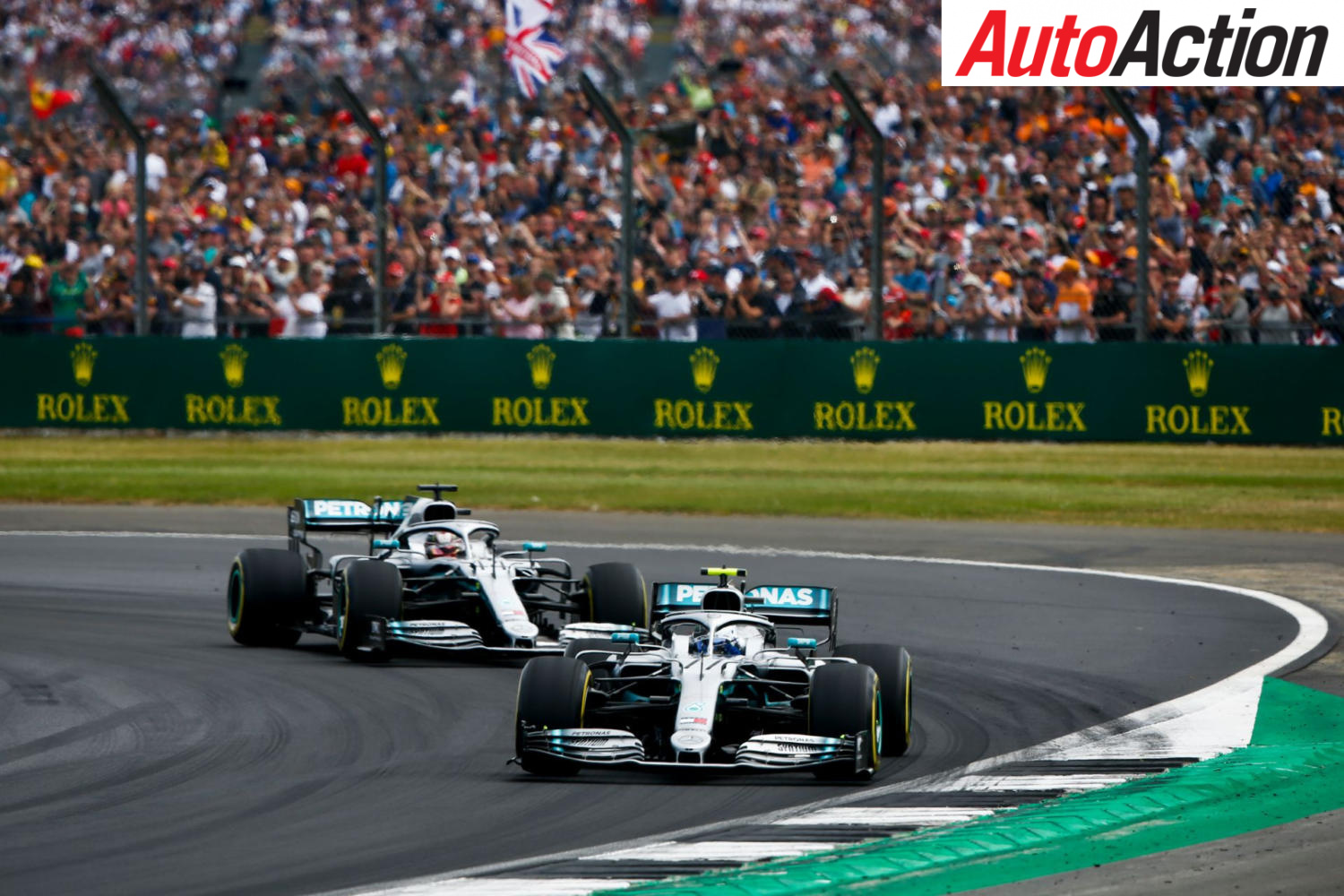
By Bruce Williams
Date posted: 23 July 2019
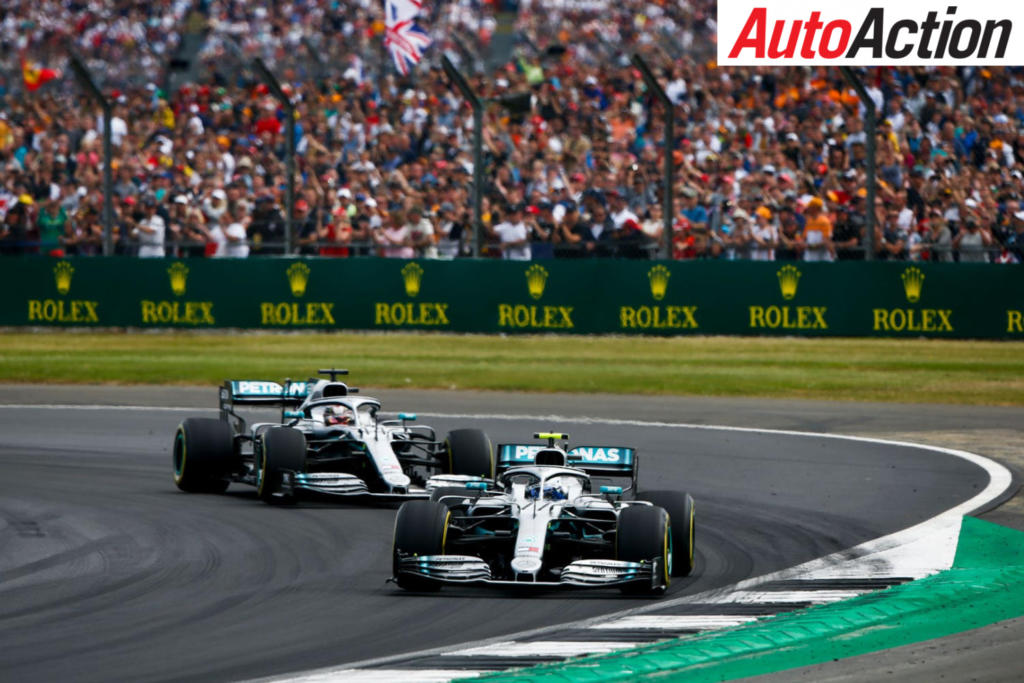
Mercedes-Benz looks back on 125 years of motorsport – Photo: LAT
Exactly 125 years ago on July 22, the first ever motorsport event was held. In honour of this milestone, Mercedes-Benz looks back at some of the most important events in its racing heritage.
THE FOUNDTION OF MOTORSPORT: THE INVENTION OF THE AUTOMOBIILE
One crucial ingredient of motorsport is, quite obviously, motorised vehicles. So one fairly important event had to precede the first ever car race – and every subsequent motorsport event since: the invention of the car.
On 29 January 1886, a 42-year-old engineer named Carl Benz filed patent no. DRP 37435 with the Imperial Patent Office in Berlin, Germany, for a “gas-powered vehicle”. This date would later become known as the day the car was born – after a number of challenges along the way. For his idea of a “horseless carriage” to work, Carl Benz had to create an engine that was both small enough to fit into a vehicle and strong enough to propel it. Ultimately, his four-stroke engine ran at 400 revolutions per minute – more than twice as fast as other engines at that time – and delivered enough power to drive a vehicle.
But Carl Benz did not just develop an engine, he designed the entire car. His “Patent Motor Car” was a three-wheel vehicle that integrated the engine as a central element with a horizontal cylinder and a large, horizontal flywheel. It was the world’s first automobile and it was invented in Mannheim, Germany, a mere half hour drive from the Hockenheim circuit.
Less than 100 kilometres away from Carl Benz’s workshop, Gottlieb Daimler and his congenial employee Wilhelm Maybach simultaneously developed a very similar machine in Cannstatt, Germany (now a part of Stuttgart). Just like Benz, Daimler and Maybach had been trying to build an engine that was small yet powerful enough to propel a vehicle.
On 3 April 1885, Daimler registered a “gas or petroleum engine” with a closed, oil- and dust-proof one-cylinder engine which could run at speeds of up to 650 revolutions per minute, producing 1.1 horsepower (0.8 kw). The first experimental vehicle in which Daimler and Maybach installed the engine was a wooden-frame two-wheel vehicle – somewhat similar to what we would call a “motorcycle” today.
It was not until 1886 that Daimler ordered a carriage and equipped it with his patented engine and a drawbar steering system. This “Motorised Carriage” was the world’s first four-wheeled automobile – developed and built only a few short months after Carl Benz had built the first ever car.
While the invention of the car is inextricably linked to the achievements of Carl Benz and Gottlieb Daimler, the story of its success in the following decades cannot be told without mentioning Bertha Benz, Carl’s wife. In his memoirs, Carl wrote the following about his wife: “In marrying, I was joined by an idealist who knew what she wanted in all things, from the insignificant to the weighty.”
Bertha not only financed Carl’s endeavours, she also realised the need for publicity for his invention. In August 1888 she went on the first long-distance automobile journey in history to prove the functionality and reliability of the car. Together with her teenage sons Eugen and Richard, but without the knowledge of her husband, she drove 100 kilometres from Mannheim to Pforzheim where she visited her mother. Upon arrival at her destination, she sent a Telegram to her husband informing him of the successful journey.
When she returned five days later, the new had spread like a wildfire and everyone was talking about the “Patent Motor Car”. In the following years, the popularity of the car rose steadily, although some critics were still not convinced that motorised vehicles would be a lasting success. Famously, the German Emperor Wilhelm II said in 1905: “I believe in horses. Automobiles are a passing phenomenon.”
Today, the fact that the invention of Carl Benz and Gottlieb Daimler changed the course of history, allowing for individual mobility and convenient long-distance travel, is widely recognised. One of the highest accolades was the admittance of Carl Benz’s Patent into the UNESCO “Memory of the World” International Documentary Heritage Register alongside other outstanding documents such as the Magna Carta, the Gutenberg Bible or Johann Sebastian Bach’s Mass in B minor.
THE BIRTH OF MOTORSPORT
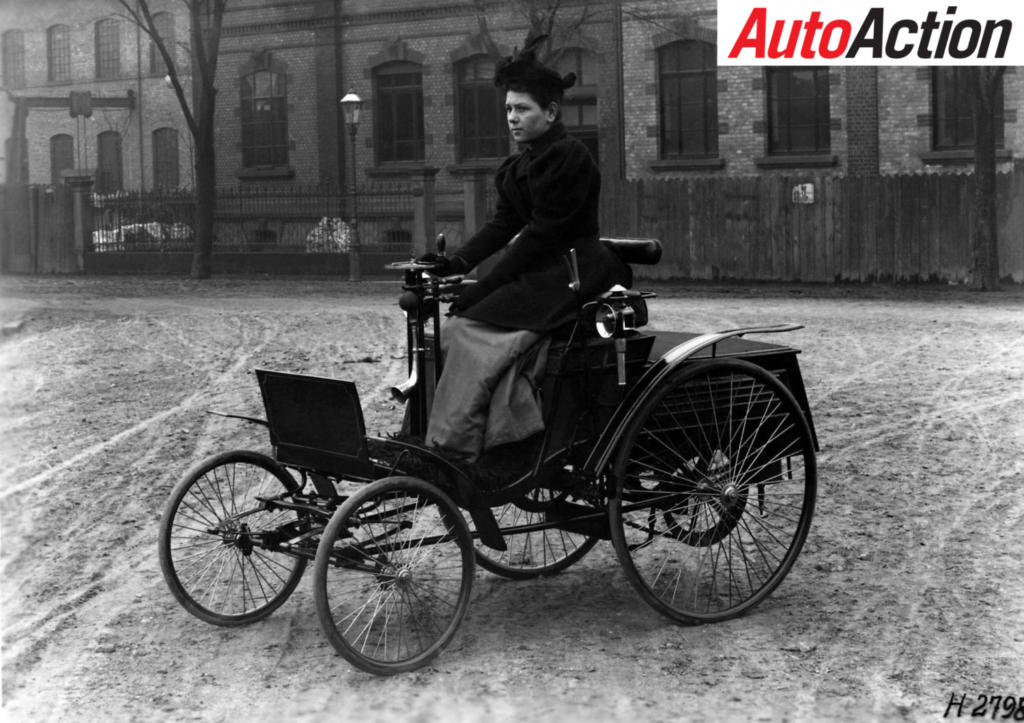
The Worlds first production car 1894 Benz Velo – Photo: LAT
In the morning of July 22, 1894, 125 years ago, 21 brave drivers lined up their vehicles on the Boulevard Maillot, right next to the Bois de Boulogne in Paris. Starting at 8 o’clock, the soon-to-be racers and a number of passengers in their cars would compete in the first ever automobile race – an endurance race, held on 127 kilometres of public roads from Paris to Rouen.
Thousands of spectators came to witness the event and made the start quite a tricky affair as the roads had not been closed to the public. A report later read: “The convoy is led, flanked and pursued by numerous cyclists, also by a number of vehicles with a mechanical propulsion system which are tackling the route as amateurs.”
The event was organised by the French newspaper “Le Petit Journal” and the regulations were worded in rather broad terms, promising victory to a horseless carriage that was “not dangerous, easy to drive, and cheap during the journey.”
After a mid-race lunch break in Mantes, the first car arrived at the finish line at 17:40, followed in due course by 16 more vehicles that completed the race. Nine of the 17 finishers were powered by 3.5 horsepower (2.6 kW), two-cylinder V-engines that had been invented by Gottlieb Daimler and were manufactured in France according to his original plans. A 5 hp (3.7 kW) Benz vehicle was also among the finishers of the race.
The first prize was given to the competitors “whose car comes closest to the ideal” outlined in the regulations and was shared between two French car manufacturers, Panhard & Levassor and Peugeot. Both vehicles were driven by the “Système Daimler” – Gottlieb Daimler’s 3.5 horsepower engine.
In their verdict, the jurors emphasised Daimler’s innovation: “The Daimler engine, developed by a skilled engineer from Württemberg; Mr. Daimler – who was present yesterday in Rouen to share in the triumph of his work – has turned petroleum or gasoline fuel into a practical solution.”
120 YEARS AGO: THE NAME MERCEDES IN MOTOR RACING CIRCLES

Motorsport in 1899 – Photo: LAT
In the end of the 19th century, a wealthy businessman named Emil Jellinek became the best customer of Gottlieb Daimler’s car company, the Daimler-Motoren-Gesellschaft (DMG). He ordered his first Daimler car in 1897 and took delivery of two more vehicles in the following year. In 1899, DMG had already supplied Jellinek with ten cars, and in 1900, with as many as 29.
Jellinek used many of the vehicles to compete in car races. In March 1899, he competed in the prestigious Nice Race Week in a Daimler “Phoenix” racing car. However, he did not participate under his real name; instead, he entered the race under the pseudonym Mercédès, the first name of his eldest daughter, Mercédès Jellinek. Emil Jellinek would continue to use the pseudonym at races and the name “Monsieur Mercédès” was commonly heard in motoring circles.
In April 1900, Jellinek and DMG signed an agreement for the order of new cars which were to be built to Jellinek’s specifications and powered by a newly designed engine that was to be called “Daimler-Mercedes”. On December 22, 1900, Jellinek took delivery of the first vehicle with the new engine – a 35 hp (26kW) racing car with a low centre of gravity, a lightweight but powerful engine and a honeycomb radiator, developed by DMG chief engineer Wilhelm Maybach. The car could reach top speeds of up to 90 km/h and is today regarded as the first modern automobile – and the first ever Mercedes. A few months later, this new type of car won virtually every contest it competed in at the Nice Race Week 1901, making the first Mercedes a true race car. DMG began marketing cars with the Mercedes designation in 1901 and lodged the designation as a tradename on 23 June 1902.
85 YEARS AGO: THE BIRTH OF THE SILVER ARROW
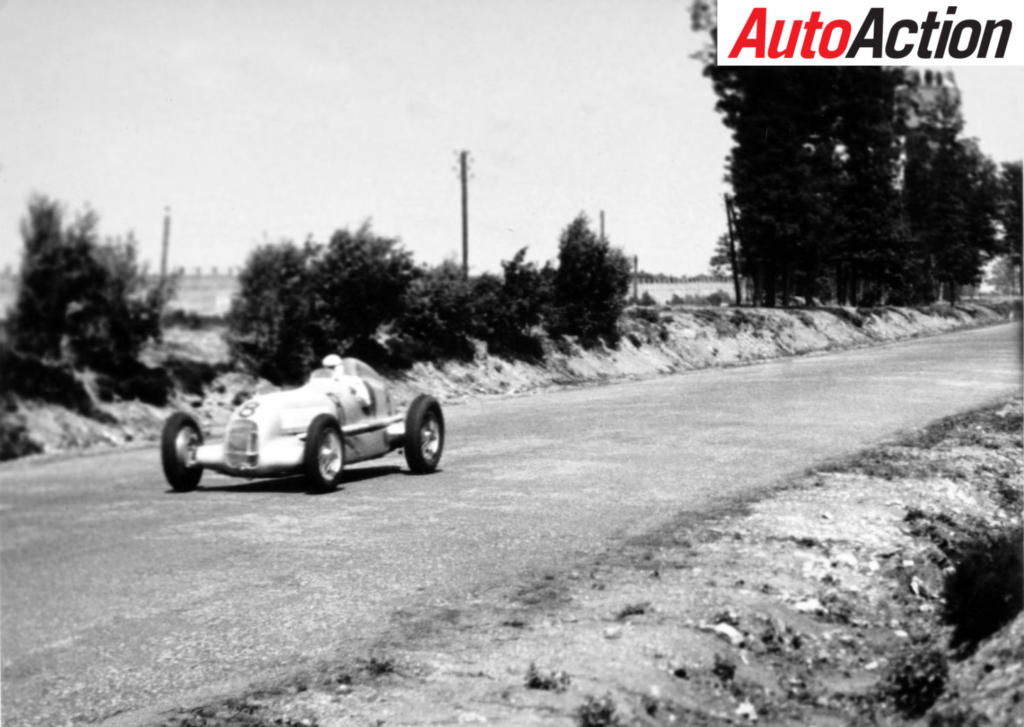
The Birth of the Silver Arrows – Photo: LAT
In the beginning of the 20th century, Grand Prix race cars used to be painted in the international auto racing colours. Those colours represented the origin of the car or the driver. British teams would compete in “British Racing Green”, French vehicles were painted in “Bleu de France” and Italian teams painted their cars red. Mercedes-Benz Grand Prix race cars were traditionally painted white, representing the German origin of the brand.
According to the legend of the Silver Arrows, this all changed in the 1930s. The Eifelrennen, held on 3 June 1934 at the Nürburgring, was the first race in which the Mercedes-Benz W 25 competed. The car was a newly designed race car for the 1934 Grand Prix season, which saw the introduction of a new set of regulations that limited the total weight of the car to 750 kilograms without fuel, oil, coolant, and tyres. Apart from the maximum weight the regulations left a lot of room for innovation, not restricting the design of the car in any other way. The Mercedes-Benz W 25 followed a classic vehicle architecture; the rear-wheel drive car was powered by a supercharged 3.4-litre in-line 8-cylinder engine that was mounted in the front and produced an output of 354 hp (260 kW).
It was a mighty race car, but according to Silver Arrows legend there was one small issue with it: when the W25 was weighed the day before its first race, it was slightly above the weight limit of 750kg. Allegedly, the team was able to bring the weight down to within regulatory limits by scraping off its white paint. Without the white paint, the metal bodywork of the car was exposed, giving it a silver look: the first Silver Arrow was born.
However, the W 25 would not only become known for its shimmering bodywork, but also for its impressive on-track performance. Manfred von Brauchitsch won the Eifelrennen in the W 25 the following day, breaking the track record with an average speed of 122.5 km/h. It was the first of many wins for the Silver Arrows. The W 25 would compete until 1937, the last year of the 750-kg formula. From 1934 to 1937, the vehicle design was constantly modified in the hunt for more performance. Within three years, the engine displacement increased to a maximum of 4.7 litres, raising the output to 646 hp (475 kW). Many famous racing drivers competed in the W 25, among them Rudolf Caracciola and Luigi Fagioli.
65 YEARS AGO: ENTERING FORMULA ONE

Mercedes-Benz made its Formula 1 debut in 1954 – Photo: LAT
In 1954 Mercedes-Benz made its Formula One debut. Since the start of the 20th century, the brand had built a reputation for developing strong and reliable race cars, so the expectations were high. However, entering a new racing series is never an easy thing to do – especially when you arrive a few years late to the party and renowned competitors such as Ferrari and Maserati had already won races in the series or even championships.
The new car had a few tricks up its sleeve though and when it was finally time to enter its first race – the French Grand Prix, held on 4 July 1954 in Reims – the W 196 showed what it was capable of. In the hands of Juan Manuel Fangio, Mercedes-Benz won its first ever Formula One race.
In its early 1954 spec, the W 196 was powered 2.5 litre, inline 8-cylinder engine with an output of 256 hp (188 kW) and came in two different body styles. There was the classic monoposto with open wheels that looked relatively similar to other Grand Prix racing cars of its time. And then there was the famous “streamliner”, a car that was aerodynamically optimised to reduce drag and therefore extremely strong on circuits with few corners and long straights. Although the streamlined version has since become an icon of motorsport history, it was actually the monoposto that competed in more races.
Mercedes-Benz stayed in Formula One for two seasons and won nine out of the twelve races in which they competed. Eight of those were won by Juan Manuel Fangio who also won the World Championship in 1954 and 1955 driving the W 196. In his first year, Juan Manuel Fangio raced alongside Karl Kling and Hans Herrmann, both of which claimed a podium in the season, as well as Hermann Lang. In the following year, Stirling Moss, André Simon, Piero Taruffi joined the team; with Moss being the only other driver alongside Fangio who won an F1 race in a Mercedes in the 1950s.
25 YEARS AGO: RETURNING TO FORMULA ONE AS AN ENGINE MANUFACTURER
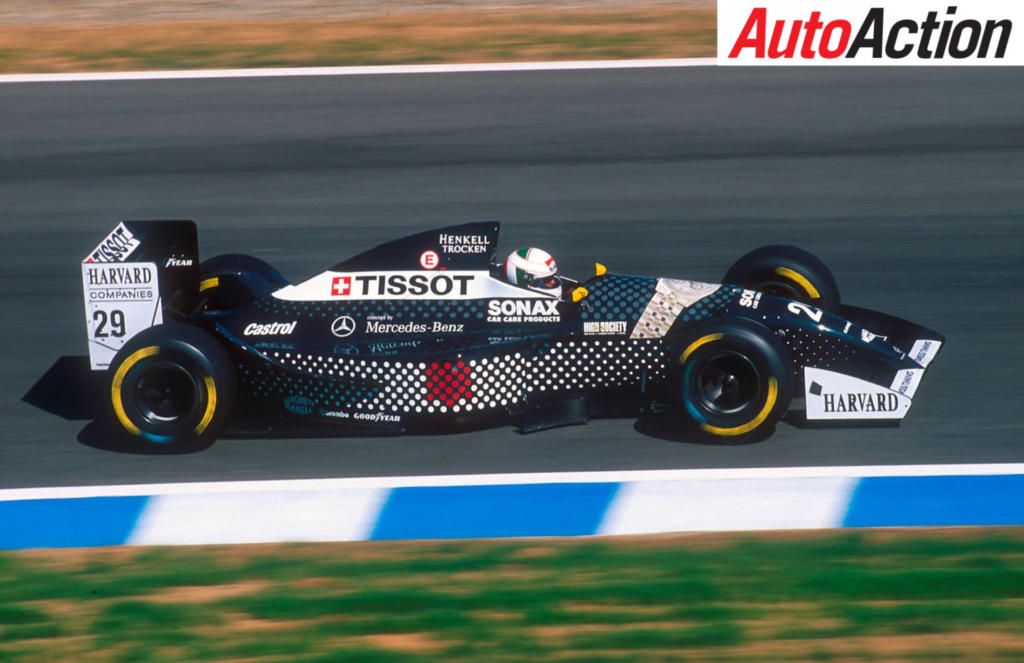
Mercedes-Benz re-entered the sport with Sauber – Photo: LAT
In 1994, 39 years after Mercedes-Benz had last competed in Formula One, the brand officially returned as an engine manufacturer for the Sauber team. The partnership was built on previous achievements racing sports cars, which saw Sauber-Mercedes win the 24 Hours of Le Mans in 1989 and the World Sports Prototype Championship in 1989 and 1990. When Sauber made its F1 debut in 1993, its Brixworth-built engine was labelled “Concept by Mercedes-Benz”; one year later the three-pointed star returned officially to the pinnacle of motorsport.
In 1995, Mercedes entered into a partnership with McLaren and won its first race in 1997. One year later, the Mercedes-powered team won the Constructors’ Championship and Mika Häkkinen the Drivers’ Championship – an achievement he would repeat again in 1999. The partnership with McLaren lasted until 2014 and Mercedes-Benz engines propelled a certain Lewis Hamilton not only to his first Formula One win in 2007, but also to his first world championship in the following year. In his entire Formula One career, Lewis has made every one of his 239 race starts with Mercedes-Benz power.
2010: A MODERN-DAY MERCEDES IN FORMULA ONE
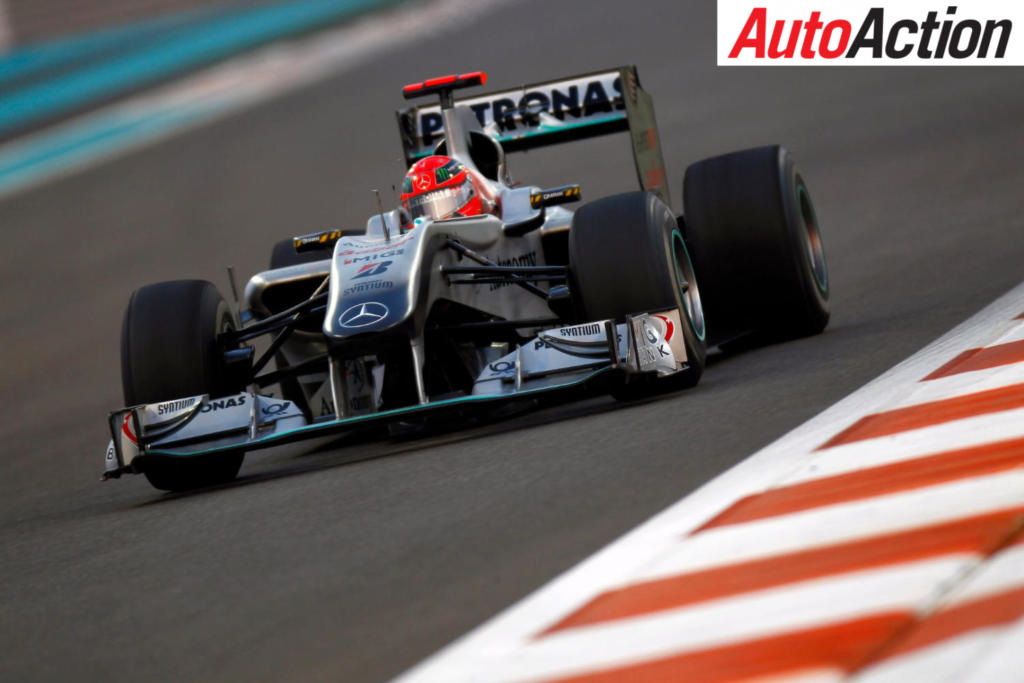
Mercedes returned with a factory team in 2010 – Photo: LAT
2019 is the tenth season for Mercedes as a modern-day works team in Formula One. The news of the return of Mercedes to the series spread quickly in 2009, an effect that was further amplified when the team announced its inaugural driver line-up: Nico Rosberg would drive alongside returning 7-time F1 World Champion Michael Schumacher. From the very beginning, the team could also count on the support of its title partner Petronas, together Mercedes and Petronas have competed in 187 Grands Prix to this day.
The return to Formula One was not always easy and the team faced tremendous challenges along the way. Mercedes competed for more than two seasons before the team took its first win at the 2012 Chinese Grand Prix – the first Mercedes victory in Formula One since Juan Manuel Fangio’s win in the 1955 Italian Grand Prix. After that, it took another year until the team would win again.
Both Lewis Hamilton and Toto Wolff joined the team for the 2013 season; a year in which the team showed some of its performance capabilities as Mercedes-AMG Petronas Motorsport came second in the Constructors’ Championship. Since 2014, the team has won five consecutive Drivers’ and Constructors’ Championships, equaling Ferrari’s record for most consecutive double championships from the early 2000s. The 2019 Mercedes-Benz Grosser Preis von Deutschland will mark another milestone in the motorsport history of the three-pointed start: the 200th race start for Mercedes-Benz in Formula One.
For Auto Action’s latest feature, pick up the latest issue of the magazine, on sale now. Also make sure you follow us on social media Facebook, Twitter, Instagram or our weekly email newsletter for all the latest updates between issues.
Recent Stories
array (
0 =>
WP_Term::__set_state(array(
'term_id' => 37,
'name' => 'F1',
'slug' => 'f1',
'term_group' => 0,
'term_taxonomy_id' => 37,
'taxonomy' => 'category',
'description' => 'An Introduction to Formula One (F1)
Formula One, or F1, is the highest class of single-seater auto racing, governed by the Fédération Internationale de l\'Automobile (FIA) and is owned by Liberty Media. The name "Formula One" refers to the set of rules or formula that all cars and drivers must comply with.
The F1 season consists of a series of races, known as Grands Prix, held on purpose-built circuits or public roads around the world. The results of each race are combined to determine two annual championships: one for drivers and one for constructors (teams).
The history of Formula One can be traced back to the pre-war Grand Prix racing, which featured open-wheel cars with supercharged engines. The first World Championship of Drivers was organised by the FIA in 1950, following the end of World War II. The first race was held at Silverstone, England, and was won by Giuseppe Farina, driving an Alfa Romeo. The first constructors\' championship was introduced in 1958 and was won by Vanwall.
Formula One has seen many changes and innovations over the years, both in terms of technology and regulations. Some of the most notable developments include the introduction of rear-engined cars in the late 1950s, the use of aerodynamic wings in the late 1960s, the adoption of turbocharged engines in the late 1970s, the emergence of electronic driver aids in the late 1980s, the switch to V10 and then V8 engines in the 1990s and 2000s, and the introduction of hybrid power units in 2014.
Formula One has also produced some of the greatest drivers and rivalries in the history of motorsport. Some of the most famous names include Juan Manuel Fangio, Jim Clark, Jackie Stewart, Niki Lauda, Ayrton Senna, Alain Prost, Michael Schumacher, Lewis Hamilton, and Sebastian Vettel. Some of the most intense battles for the championship have been between Fangio and Stirling Moss in the 1950s, Lauda and James Hunt in the 1970s, Senna and Prost in the late 1980s, Schumacher and Mika Hakkinen in the late 1990s, and Hamilton and Vettel in the 2010s.
Formula One is widely regarded as the pinnacle of motorsport, attracting millions of fans and viewers worldwide. The sport is also a huge business, involving billions of dollars in revenue and expenditure. The teams compete for prize money, sponsorship deals, and media rights, while the drivers earn millions of dollars in salaries and endorsements. The sport is also influenced by politics, regulations, and controversies, such as doping scandals, espionage cases, safety issues, and environmental concerns.
The following is a list of all F1 World Drivers Champions by year, from 1950 to 2020:
1950-1959
1950: Giuseppe Farina (Italy) - Alfa Romeo 158, Alfa Romeo
1951: Juan Manuel Fangio (Argentina) - Alfa Romeo 159, Alfa Romeo
1952: Alberto Ascari (Italy) - Ferrari 500, Ferrari
1953: Alberto Ascari (Italy) - Ferrari 500, Ferrari
1954: Juan Manuel Fangio (Argentina) - Maserati 250F, Maserati / Mercedes-Benz W196, Mercedes-Benz
1955: Juan Manuel Fangio (Argentina) - Mercedes-Benz W196, Mercedes-Benz
1956: Juan Manuel Fangio (Argentina) - Ferrari D50, Ferrari
1957: Juan Manuel Fangio (Argentina) - Maserati 250F, Maserati
1958: Mike Hawthorn (United Kingdom) - Ferrari 246, Ferrari
1959: Jack Brabham (Australia) - Cooper T51, Cooper-Climax
1960-1969
1960: Jack Brabham (Australia) - Cooper T53, Cooper-Climax
1961: Phil Hill (United States) - Ferrari 156, Ferrari
1962: Graham Hill (United Kingdom) - BRM P57, BRM
1963: Jim Clark (United Kingdom) - Lotus 25, Lotus-Climax
1964: John Surtees (United Kingdom) - Ferrari 158, Ferrari
1965: Jim Clark (United Kingdom) - Lotus 33, Lotus-Climax
1966: Jack Brabham (Australia) - Brabham BT19, Brabham-Repco
1967: Denny Hulme (New Zealand) - Brabham BT20, Brabham-Repco
1968: Graham Hill (United Kingdom) - Lotus 49, Lotus-Ford
1969: Jackie Stewart (United Kingdom) - Matra MS80, Matra-Ford
1970-1979
1970: Jochen Rindt (Austria) - Lotus 72, Lotus-Ford
1971: Jackie Stewart (United Kingdom) - Tyrrell 003, Tyrrell-Ford
1972: Emerson Fittipaldi (Brazil) - Lotus 72D, Lotus-Ford
1973: Jackie Stewart (United Kingdom) - Tyrrell 006, Tyrrell-Ford
1974: Emerson Fittipaldi (Brazil) - McLaren M23, McLaren-Ford
1975: Niki Lauda (Austria) - Ferrari 312T, Ferrari
1976: James Hunt (United Kingdom) - McLaren M23, McLaren-Ford
1977: Niki Lauda (Austria) - Ferrari 312T2, Ferrari
1978: Mario Andretti (United States) - Lotus 79, Lotus-Ford
1979: Jody Scheckter (South Africa) - Ferrari 312T4, Ferrari
1980-1989
1980: Alan Jones (Australia) - Williams FW07B, Williams-Ford
1981: Nelson Piquet (Brazil) - Brabham BT49C, Brabham-Ford
1982: Keke Rosberg (Finland) - Williams FW08, Williams-Ford
1983: Nelson Piquet (Brazil) - Brabham BT52, Brabham-BMW
1984: Niki Lauda (Austria) - McLaren MP4/2, McLaren-TAG
1985: Alain Prost (France) - McLaren MP4/2B, McLaren-TAG
1986: Alain Prost (France) - McLaren MP4/2C, McLaren-TAG
1987: Nelson Piquet (Brazil) - Williams FW11B, Williams-Honda
1988: Ayrton Senna (Brazil) - McLaren MP4/4, McLaren-Honda
1989: Alain Prost (France) - McLaren MP4/5, McLaren-Honda
1990-1999
1990: Ayrton Senna (Brazil) - McLaren MP4/5B, McLaren-Honda
1991: Ayrton Senna (Brazil) - McLaren MP4/6, McLaren-Honda
1992: Nigel Mansell (United Kingdom) - Williams FW14B, Williams-Renault
1993: Alain Prost (France) - Williams FW15C, Williams-Renault
1994: Michael Schumacher (Germany) - Benetton B194, Benetton-Ford
1995: Michael Schumacher (Germany) - Benetton B195, Benetton-Renault
1996: Damon Hill (United Kingdom) - Williams FW18, Williams-Renault
1997: Jacques Villeneuve (Canada) - Williams FW19, Williams-Renault
1998: Mika Häkkinen (Finland) - McLaren MP4/13, McLaren-Mercedes
1999: Mika Häkkinen (Finland) - McLaren MP4/14, McLaren-Mercedes
2000-2009
2000: Michael Schumacher (Germany) - Ferrari F1-2000, Ferrari
2001: Michael Schumacher (Germany) - Ferrari F2001, Ferrari
2002: Michael Schumacher (Germany) - Ferrari F2002, Ferrari
2003: Michael Schumacher (Germany) - Ferrari F2003-GA, Ferrari
2004: Michael Schumacher (Germany) - Ferrari F2004, Ferrari
2005: Fernando Alonso (Spain) - Renault R25, Renault
2006: Fernando Alonso (Spain) - Renault R26, Renault
2007: Kimi Räikkönen (Finland) - Ferrari F2007, Ferrari
2008: Lewis Hamilton (United Kingdom) - McLaren MP4-23, McLaren-Mercedes
2009: Jenson Button (United Kingdom) - Brawn BGP 001, Brawn-Mercedes
2010-2020
2010: Sebastian Vettel (Germany) - Red Bull RB6, Red Bull-Renault
2011: Sebastian Vettel (Germany) - Red Bull RB7, Red Bull-Renault
2012: Sebastian Vettel (Germany) - Red Bull RB8, Red Bull-Renault
2013: Sebastian Vettel (Germany) - Red Bull RB9, Red Bull-Renault
2014: Lewis Hamilton (United Kingdom) - Mercedes F1 W05 Hybrid, Mercedes
2015: Lewis Hamilton (United Kingdom) - Mercedes F1 W06 Hybrid, Mercedes
2016: Nico Rosberg (Germany) - Mercedes F1 W07 Hybrid, Mercedes
2017: Lewis Hamilton (United Kingdom) - Mercedes F1 W08 EQ Power+, Mercedes
2018: Lewis Hamilton (United Kingdom) - Mercedes F1 W09 EQ Power+, Mercedes
2019: Lewis Hamilton (United Kingdom) - Mercedes F1 W10 EQ Power+, Mercedes
2020: Lewis Hamilton (United Kingdom) - Mercedes F1 W11 EQ Power+, Mercedes
2021-
2021: Max Verstappen (Netherlands) – Red Bull RB16B, Honda
2022: Max Verstappen (Netherlands) – Red Bull RB18, Red Bull Power Trains Honda
2023: Max Verstappen (Netherlands) – Red Bull RB19, Red Bull Power Trains Honda
2024: Max Verstappen (Netherlands) – Red Bull RB20, Red Bull Power Trains Honda',
'parent' => 660,
'count' => 2833,
'filter' => 'raw',
'cat_ID' => 37,
'category_count' => 2833,
'category_description' => 'An Introduction to Formula One (F1)
Formula One, or F1, is the highest class of single-seater auto racing, governed by the Fédération Internationale de l\'Automobile (FIA) and is owned by Liberty Media. The name "Formula One" refers to the set of rules or formula that all cars and drivers must comply with.
The F1 season consists of a series of races, known as Grands Prix, held on purpose-built circuits or public roads around the world. The results of each race are combined to determine two annual championships: one for drivers and one for constructors (teams).
The history of Formula One can be traced back to the pre-war Grand Prix racing, which featured open-wheel cars with supercharged engines. The first World Championship of Drivers was organised by the FIA in 1950, following the end of World War II. The first race was held at Silverstone, England, and was won by Giuseppe Farina, driving an Alfa Romeo. The first constructors\' championship was introduced in 1958 and was won by Vanwall.
Formula One has seen many changes and innovations over the years, both in terms of technology and regulations. Some of the most notable developments include the introduction of rear-engined cars in the late 1950s, the use of aerodynamic wings in the late 1960s, the adoption of turbocharged engines in the late 1970s, the emergence of electronic driver aids in the late 1980s, the switch to V10 and then V8 engines in the 1990s and 2000s, and the introduction of hybrid power units in 2014.
Formula One has also produced some of the greatest drivers and rivalries in the history of motorsport. Some of the most famous names include Juan Manuel Fangio, Jim Clark, Jackie Stewart, Niki Lauda, Ayrton Senna, Alain Prost, Michael Schumacher, Lewis Hamilton, and Sebastian Vettel. Some of the most intense battles for the championship have been between Fangio and Stirling Moss in the 1950s, Lauda and James Hunt in the 1970s, Senna and Prost in the late 1980s, Schumacher and Mika Hakkinen in the late 1990s, and Hamilton and Vettel in the 2010s.
Formula One is widely regarded as the pinnacle of motorsport, attracting millions of fans and viewers worldwide. The sport is also a huge business, involving billions of dollars in revenue and expenditure. The teams compete for prize money, sponsorship deals, and media rights, while the drivers earn millions of dollars in salaries and endorsements. The sport is also influenced by politics, regulations, and controversies, such as doping scandals, espionage cases, safety issues, and environmental concerns.
The following is a list of all F1 World Drivers Champions by year, from 1950 to 2020:
1950-1959
1950: Giuseppe Farina (Italy) - Alfa Romeo 158, Alfa Romeo
1951: Juan Manuel Fangio (Argentina) - Alfa Romeo 159, Alfa Romeo
1952: Alberto Ascari (Italy) - Ferrari 500, Ferrari
1953: Alberto Ascari (Italy) - Ferrari 500, Ferrari
1954: Juan Manuel Fangio (Argentina) - Maserati 250F, Maserati / Mercedes-Benz W196, Mercedes-Benz
1955: Juan Manuel Fangio (Argentina) - Mercedes-Benz W196, Mercedes-Benz
1956: Juan Manuel Fangio (Argentina) - Ferrari D50, Ferrari
1957: Juan Manuel Fangio (Argentina) - Maserati 250F, Maserati
1958: Mike Hawthorn (United Kingdom) - Ferrari 246, Ferrari
1959: Jack Brabham (Australia) - Cooper T51, Cooper-Climax
1960-1969
1960: Jack Brabham (Australia) - Cooper T53, Cooper-Climax
1961: Phil Hill (United States) - Ferrari 156, Ferrari
1962: Graham Hill (United Kingdom) - BRM P57, BRM
1963: Jim Clark (United Kingdom) - Lotus 25, Lotus-Climax
1964: John Surtees (United Kingdom) - Ferrari 158, Ferrari
1965: Jim Clark (United Kingdom) - Lotus 33, Lotus-Climax
1966: Jack Brabham (Australia) - Brabham BT19, Brabham-Repco
1967: Denny Hulme (New Zealand) - Brabham BT20, Brabham-Repco
1968: Graham Hill (United Kingdom) - Lotus 49, Lotus-Ford
1969: Jackie Stewart (United Kingdom) - Matra MS80, Matra-Ford
1970-1979
1970: Jochen Rindt (Austria) - Lotus 72, Lotus-Ford
1971: Jackie Stewart (United Kingdom) - Tyrrell 003, Tyrrell-Ford
1972: Emerson Fittipaldi (Brazil) - Lotus 72D, Lotus-Ford
1973: Jackie Stewart (United Kingdom) - Tyrrell 006, Tyrrell-Ford
1974: Emerson Fittipaldi (Brazil) - McLaren M23, McLaren-Ford
1975: Niki Lauda (Austria) - Ferrari 312T, Ferrari
1976: James Hunt (United Kingdom) - McLaren M23, McLaren-Ford
1977: Niki Lauda (Austria) - Ferrari 312T2, Ferrari
1978: Mario Andretti (United States) - Lotus 79, Lotus-Ford
1979: Jody Scheckter (South Africa) - Ferrari 312T4, Ferrari
1980-1989
1980: Alan Jones (Australia) - Williams FW07B, Williams-Ford
1981: Nelson Piquet (Brazil) - Brabham BT49C, Brabham-Ford
1982: Keke Rosberg (Finland) - Williams FW08, Williams-Ford
1983: Nelson Piquet (Brazil) - Brabham BT52, Brabham-BMW
1984: Niki Lauda (Austria) - McLaren MP4/2, McLaren-TAG
1985: Alain Prost (France) - McLaren MP4/2B, McLaren-TAG
1986: Alain Prost (France) - McLaren MP4/2C, McLaren-TAG
1987: Nelson Piquet (Brazil) - Williams FW11B, Williams-Honda
1988: Ayrton Senna (Brazil) - McLaren MP4/4, McLaren-Honda
1989: Alain Prost (France) - McLaren MP4/5, McLaren-Honda
1990-1999
1990: Ayrton Senna (Brazil) - McLaren MP4/5B, McLaren-Honda
1991: Ayrton Senna (Brazil) - McLaren MP4/6, McLaren-Honda
1992: Nigel Mansell (United Kingdom) - Williams FW14B, Williams-Renault
1993: Alain Prost (France) - Williams FW15C, Williams-Renault
1994: Michael Schumacher (Germany) - Benetton B194, Benetton-Ford
1995: Michael Schumacher (Germany) - Benetton B195, Benetton-Renault
1996: Damon Hill (United Kingdom) - Williams FW18, Williams-Renault
1997: Jacques Villeneuve (Canada) - Williams FW19, Williams-Renault
1998: Mika Häkkinen (Finland) - McLaren MP4/13, McLaren-Mercedes
1999: Mika Häkkinen (Finland) - McLaren MP4/14, McLaren-Mercedes
2000-2009
2000: Michael Schumacher (Germany) - Ferrari F1-2000, Ferrari
2001: Michael Schumacher (Germany) - Ferrari F2001, Ferrari
2002: Michael Schumacher (Germany) - Ferrari F2002, Ferrari
2003: Michael Schumacher (Germany) - Ferrari F2003-GA, Ferrari
2004: Michael Schumacher (Germany) - Ferrari F2004, Ferrari
2005: Fernando Alonso (Spain) - Renault R25, Renault
2006: Fernando Alonso (Spain) - Renault R26, Renault
2007: Kimi Räikkönen (Finland) - Ferrari F2007, Ferrari
2008: Lewis Hamilton (United Kingdom) - McLaren MP4-23, McLaren-Mercedes
2009: Jenson Button (United Kingdom) - Brawn BGP 001, Brawn-Mercedes
2010-2020
2010: Sebastian Vettel (Germany) - Red Bull RB6, Red Bull-Renault
2011: Sebastian Vettel (Germany) - Red Bull RB7, Red Bull-Renault
2012: Sebastian Vettel (Germany) - Red Bull RB8, Red Bull-Renault
2013: Sebastian Vettel (Germany) - Red Bull RB9, Red Bull-Renault
2014: Lewis Hamilton (United Kingdom) - Mercedes F1 W05 Hybrid, Mercedes
2015: Lewis Hamilton (United Kingdom) - Mercedes F1 W06 Hybrid, Mercedes
2016: Nico Rosberg (Germany) - Mercedes F1 W07 Hybrid, Mercedes
2017: Lewis Hamilton (United Kingdom) - Mercedes F1 W08 EQ Power+, Mercedes
2018: Lewis Hamilton (United Kingdom) - Mercedes F1 W09 EQ Power+, Mercedes
2019: Lewis Hamilton (United Kingdom) - Mercedes F1 W10 EQ Power+, Mercedes
2020: Lewis Hamilton (United Kingdom) - Mercedes F1 W11 EQ Power+, Mercedes
2021-
2021: Max Verstappen (Netherlands) – Red Bull RB16B, Honda
2022: Max Verstappen (Netherlands) – Red Bull RB18, Red Bull Power Trains Honda
2023: Max Verstappen (Netherlands) – Red Bull RB19, Red Bull Power Trains Honda
2024: Max Verstappen (Netherlands) – Red Bull RB20, Red Bull Power Trains Honda',
'cat_name' => 'F1',
'category_nicename' => 'f1',
'category_parent' => 660,
)),
1 =>
WP_Term::__set_state(array(
'term_id' => 6,
'name' => 'Features',
'slug' => 'features',
'term_group' => 0,
'term_taxonomy_id' => 6,
'taxonomy' => 'category',
'description' => 'AA looks beyond the news',
'parent' => 0,
'count' => 291,
'filter' => 'raw',
'cat_ID' => 6,
'category_count' => 291,
'category_description' => 'AA looks beyond the news',
'cat_name' => 'Features',
'category_nicename' => 'features',
'category_parent' => 0,
)),
)













